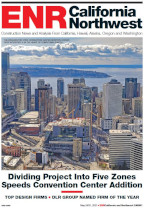“Many of these college graduates would have gone to work for private industry and not looked for public service if the job market wasn’t so tight,” he says. “This has allowed us to see talent that we would otherwise not have been able to recruit.”
As for green building, Altendorf says the corps is focusing on military jobs, where it is a requirement that all army and air force projects be LEED silver, and on aspects such as sustainability for horizontal construction.
“Sustainable horizontal construction is a little different because it’s not as cut and dry as vertical construction,” she says. “We are doing horizontal levees and dredging for ports and trying to come up with designs to meet the sustainability challenge.”
She says the corps is getting creative with dredge materials that used to be dumped out to sea.
“What we are trying to do now is use dredged material for beaches or to develop wetlands,” she says. As an example of this she points to the Hamilton Wetlands Restoration Project, which used dredged material from the Port of Oakland. “Waste from one project can be a valuable resource for another project,” she says.
The decade-long project, costing between $250 million and $300 million, is located on the site of an old World War II airfield, along the northwestern shore of San Pablo Bay, in the northern reach of the San Francisco Bay Estuary.
div id="articleExtras"



Post a comment to this article
Report Abusive Comment